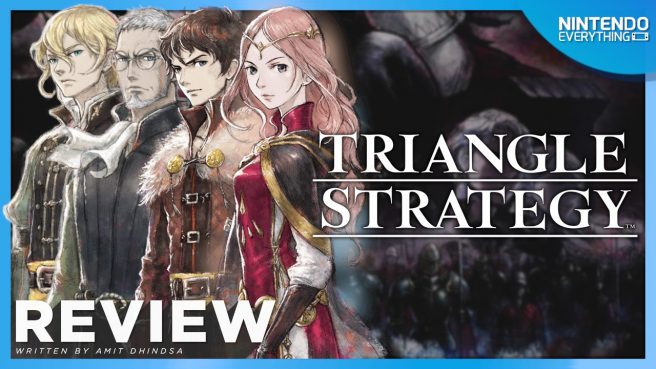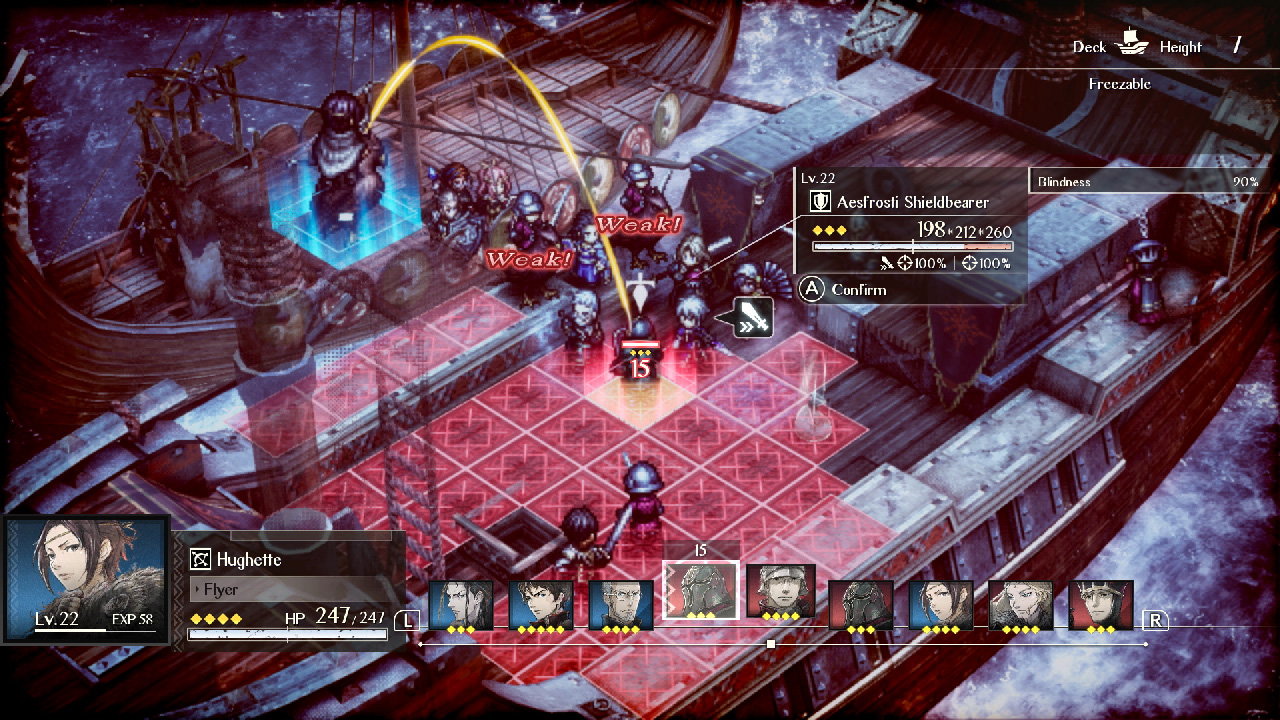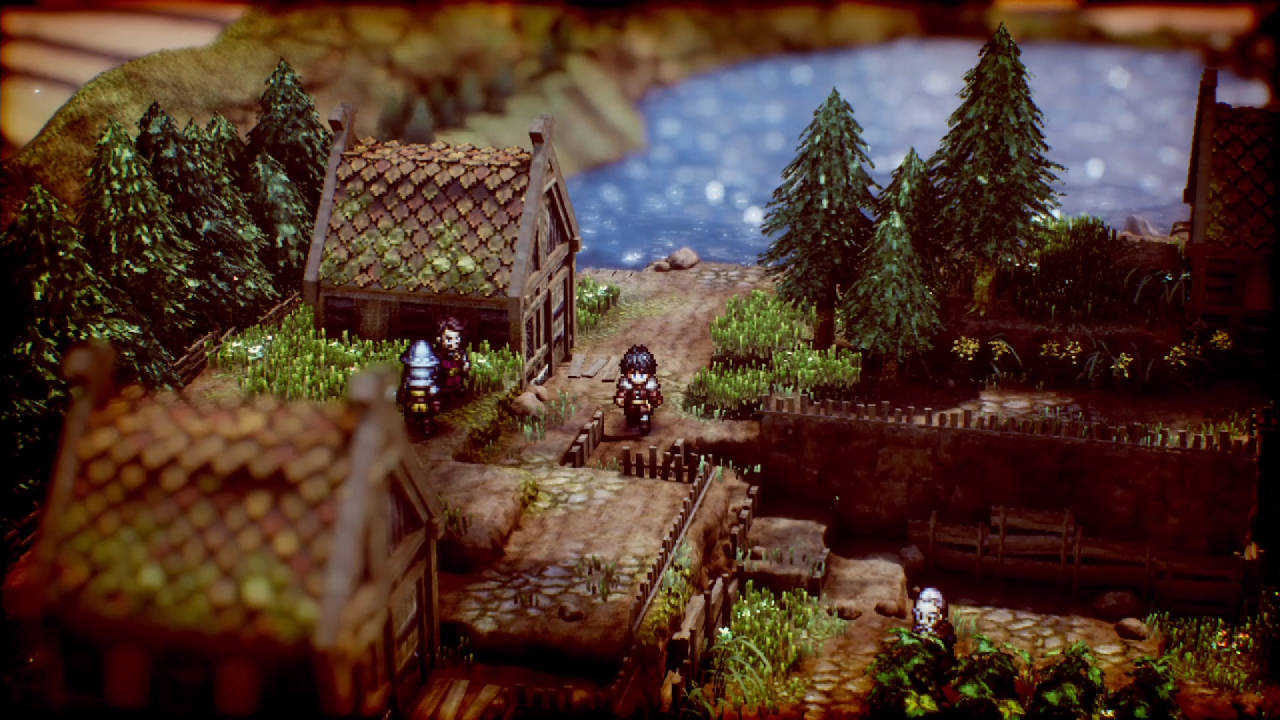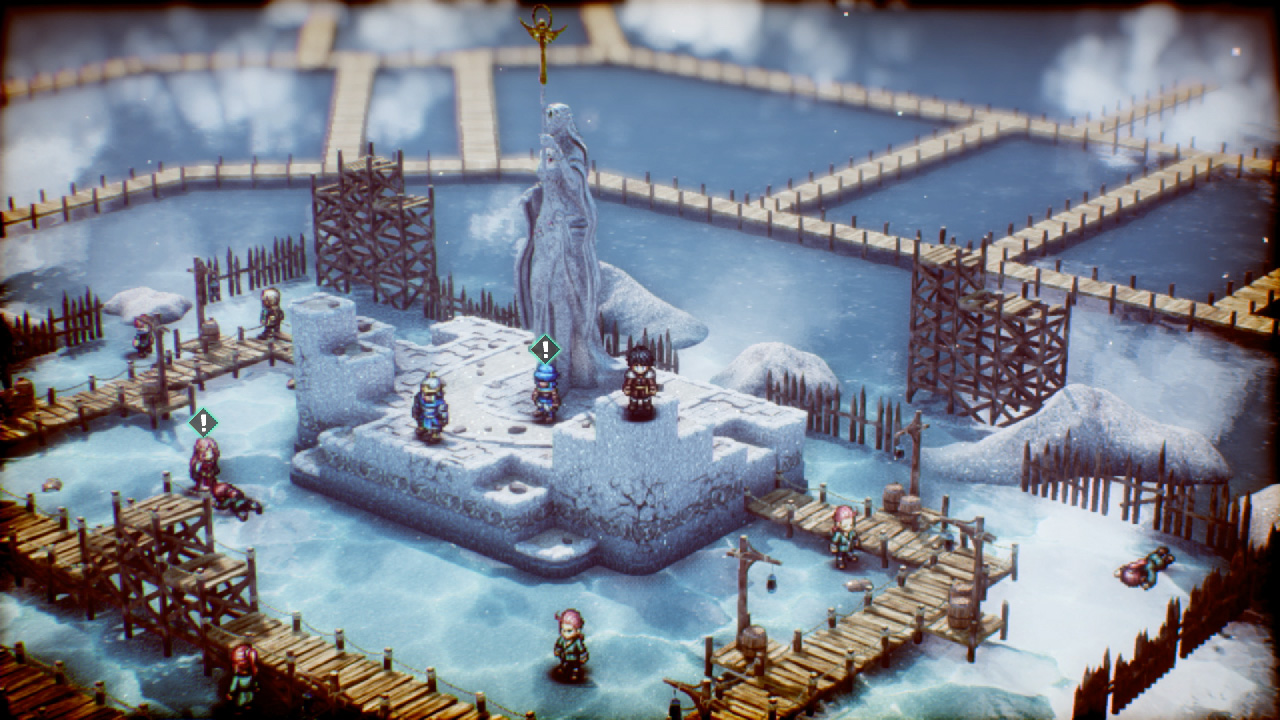[Review] Triangle Strategy
System: Switch
Release date: March 4, 2022
Developer: Square Enix / Artdink
Publisher: Square Enix
Square Enix’s Team Asano has been a force to be reckoned with on Switch. Their debut on the system, Octopath Traveler, was a showpiece at the first real Switch blowout in January 2017 and released the following year to great acclaim. Returning to the glory of their 3DS days, the highly requested Bravely Default 2 came out just last year. Now the third entry in the team’s Switch JRPG trifecta returns to Octopath’s HD-2D style, but delivers gameplay so different that it might as well be considered a different genre. That certainly doesn’t hold it back however: different as it is, Triangle Strategy is a tremendous overall package and possibly Team Asano’s finest work yet.
Triangle Strategy tells the tale of Norzelia, a vast land comprised of three great nations. Aesfrost is an industrious nation ruling the frigid North, valuing freedom above all else, whose economy relies heavily on exporting iron. The Holy State of Hyzante is a deeply religious state occupying the deserts of the East and with its monopoly on Norzelia’s lone source of salt, is arguably the most powerful of the three nations. A country deeply rooted in tradition, Glenbrook sits in the middle of the other two powers, and boasts bountiful fields as well as the Great Norzelian River, essential to trade throughout the land.
While Norzelia currently enjoys a period free from larger conflict, a great war ravaged the land 30 years ago claiming many lives on all sides. Finally sensing their mutual demise, Aesfrost and Hyzante turned to House Wolfortt, one of the three high houses of Glenbrook known for its military prowess, to broker peace between the three nations, and House Wolfortt succeeded in negotiating a ceasefire. In order to strengthen relations between the three nations in the present day, the monarch of Glenbrook spearheads a joint mining venture between Glenbrook, Aesfrost, and Hyzante. Rather than bring the nations closer together, however, the partnership only serves to bring the true aims of Aesfrost and Hyzante to a head, and the tenuous peace in Norzelia slowly unravels as the flames of war spark anew. At the center of the conflict is Serenoa, young heir to the mighty House Wolfortt and his recently betrothed Frederica, a daughter of Aesfrost’s ruling family. Along with their allies, the two navigate a tragic, gripping, and winding tale together, having to make heart-wrenching choices and sacrifices along the way.
Suffice it to say, Triangle Strategy leans harder into its political themes than many other games in the genre. While series like Fire Emblem touch on similar subject matter (to varying degrees between entries), Triangle Strategy not only features a political backdrop, but explores in depth the long-term ramifications of a monarch’s decisions, the subterfuge necessary to survive a political battlefield, the toll conflict takes on the people of a nation, the importance of surrounding yourself with trusted and reliable aides, and ultimately, what it truly means to be a leader. It’s not easy to intelligently weave this nature of subject matter into an entertaining story, but that’s where Triangle Strategy’s writing shines: Team Asano successfully created a narrative that’s smart, captivating, and relatable all at once.
Central to the game’s broader themes are three convictions: liberty, morality, and utility, loosely defined as freedom, justice, and self-preservation, respectively. Serenoa’s convictions in each of the three will strengthen depending on how he answers certain questions throughout the game as well as the course of action the party makes at pivotal junctions in the story. These decision points also change the story in drastic ways, leading to completely different events and battles depending on the chosen path. The party is often split amongst which route to go in these moments, owing to the fact that they all come from different walks of life.
While Serenoa has no vote himself, he can influence the decisions of his comrades. Doing so can prove challenging, however: each choice in these votes is aligned with one of the three convictions, and if Serenoa’s is not yet strong enough in the conviction corresponding to the choice you want to make, it can be difficult (or downright impossible) to influence the party. In order to give yourself the best chance at going down your ideal path, it’s best to make use of the exploration sections that are present in most chapters containing a vote.
Triangle Strategy doesn’t feature overworld exploration like Octopath Traveler and Bravely Default 2, but it does have smaller explorable areas beautifully presented in the HD-2D style. In addition to picking up useful items and money strewn about, you can arm yourself with knowledge that can help persuade Serenoa’s retinue to support your desired path of action by getting information from the supporting characters. The other main purpose in many of these sections is a clever one: an opportunity to scout the battlefield prior to the party deploying for combat.
By allowing players to explore the terrain before a battle, Triangle Strategy sidesteps a problem many tactical RPGs share. Without fully understanding the terrain of a map, it can be difficult to accurately choose which party members, items, and strategies to bring into battle, either forcing a restart early into your first attempt or trying to salvage a bad start that stems from incomplete information. It’s particularly important in Triangle Strategy, as there’s a heavy focus on verticality in the game’s maps and systems.
Instead of the sprawling, relatively flat maps that some tactical RPGs feature, Triangle Strategy trades square footage for verticality. Higher ground can range from levels between 1 to over 10, and being on higher elevation grants units various boons such as increased damage, greater range, and kudos (a separate form of currency that can be exchanged for extremely useful items at the sundry shop).
Positioning is a key focus in Triangle Strategy beyond just height: even the way a unit faces at the end of a turn is pivotal. Units can face one of the four cardinal directions at the end of their turn, and if a unit attacks an enemy from the back, they automatically land a critical hit (dealing extra damage). To add yet another layer to the formula, if any unit is sandwiched between two enemy units, the second enemy unit will perform a follow up attack. There’s a lot to consider when positioning units in Triangle Strategy; sending a unit far afield on its own is often a recipe for disaster, and capitalizing on an enemy’s poor positioning is paramount to a swift victory.
Equally as important as positioning is turn order. Turn order is in a constant state of flux, largely dependent on the speed stat of all units, and can be delayed or expedited using abilities. The turn order for all units on the field for the next 30 turns is visible at the bottom of the screen, and managing the turns of enemies and allies alike is an important part of the game. For example, if an enemy boss has a turn coming up sooner than your healer’s and many of your units are worse for wear, delaying the enemy’s turn (or expediting your healer’s) can be the difference between victory and defeat. It’s important to note that not all units have these abilities, however, as the majority of attacks and abilities are unique to specific units in the game.
While some units focus on influencing turn order, others focus on magic, and some on healing. Units in Triangle Strategy are highly specialized with each unit filling its own role. For those who enjoy building units in tactical RPGs, there’s not much of it here (although you will still find the familiar RPG satisfaction of seeing characters level up and upgrade their appearance in cool ways during weapon and class upgrades). The only real decisions to make are which order to unlock a unit’s attributes in and which units to promote first (with unit classes and the upgrade path being unique, and locked, to each unit as well). To compound the lack of customization, unlocking attributes can feel restrictive, as the materials necessary for the process are scarce. This is partly mitigated by optional battles in the Wolfortt army’s encampment which can be used to win materials, grind money to buy whatever materials the merchant has in stock at the time, and also to gain experience and try out additional units. The tradeoff for a lack of customization is likely more opportunity for the development team to make more engaging battles, since they more or less know what each unit can do, and it’s one that I think was worth it as the battles in the game feel well crafted.
One way the game makes up for its lack of unit customization is the sheer amount of unique units that it throws at you. Many optional units are unlocked throughout the game as side stories that appear on the world map between battles, which usually consist of a cutscene giving a little background on the new character and their reasons for wanting to join the Wolfortt army (with further details on their backstory coming in additional side stories later on). Some units may seem weak at first, but due to the unique nature of Triangle Strategy’s mechanics and maps, you will quickly find that some of these optional characters are among the most useful in the game depending on the situation.
Jens, the group’s blacksmith, cannot do a lick of damage, but his ability to build ladders (and place traps in front of them lest an enemy try to make us of them as well) drastically changed my fortunes for the better on a map where Serenoa’s army found itself surrounding by enemies on cliffs on both sides. What could have been a slog to get my units safely to higher ground became a simple task, and getting a good start in Triangle Strategy’s battles is important since that will make or break a successful run. Weathering the early storm and whittling down the enemy forces requires careful maneuvering in the beginning, but once the enemy’s forces are down to less than half, the rest tend to crumble in a fraction of the time.
The myriad layers of decision making make Triangle Strategy difficult, but it’s also part of what makes the game fun. Having a unit face the wrong way can be the difference between your character surviving another turn and being defeated, but forcing enemy units into a precarious situation of your design and capitalizing on it just as you planned is tremendously satisfying. There’s also a reprieve in no permanent death and generous defeat conditions. In almost all chapters, the only way to lose is if Serenoa’s entire army falls. Even in chapters where specific characters are being targeted in the story, that unit can usually fall without the battle ending. The stand that Triangle Strategy takes with its battles is a simple one: they can be difficult, they can go downhill fast, but as long as you decimate the enemy forces with at least one of your units still standing, you have earned a victory without penalty. It’s an approach that makes the challenge of its battles fun and engaging and removes any additional barriers that could lead to frustration if they were also part of the equation.
Given that Triangle Strategy is a very story heavy game, there are also lower difficulty settings that can take the sting out of battles if a difficult tactical RPG isn’t the main draw for some. These options are a larger part of Team Asano’s continued focus on player experience going back to the original Bravely Default on 3DS. Players can fast forward through battle animations and cutscenes (and outright skip the latter), difficulty can be adjusted up and down throughout the game, dialogue can be reviewed again if a line was accidentally skipped, and there are graphical tweaks based on player feedback from the demos. In addition, the game features dual audio in English and Japanese for its extensive voice acting. It’s great to see a team focus on eliminating as many obstacles as they can from players enjoying their game and giving them additional tools to elevate the experience.
A final note on the narrative of Triangle Strategy. While I have immense praise for the quality of the writing and how the story is presented, and found it to be an enthralling tale from start to finish, my feelings are more mixed on how the game handles its endings. Triangle Strategy features multiple endings, but also one route akin to a “true” ending. Having seen the choices necessary to trigger this route, the decisions are seemingly arbitrary with no common point between them or in-game hints that these are the “right” choice. On one hand, it’s understandable that the game wouldn’t nudge players in one direction over another, as that would undermine the freedom to make choices that you personally feel are right, but a true ending route dependent on predetermined actions does that by its very nature. I enjoyed the ending that unfolded for me, but the game also makes it very clear that a better ending is out there through a massive cliffhanger involving one of the main characters. Even the ending screen for this route makes it clear that not all is right in a subtle but very impactful way.
To further complicate the process, it’s entirely possible (and even likely) for someone to end up in a situation where they cannot sway the vote in the way they want because Serenoa’s conviction is not high enough in that area. Not only can that effectively lock someone out of the true ending, but it can also lock them out of a course of action they want to take and force them to commit to something they feel is objectionable. Triangle Strategy’s new game+ mode mitigates this to some extent, by making clear which conviction a choice will impact and by how much and also allows players to see where they stand with each conviction early in the campaign. The multiple endings and robust new game+ mode (which carries over levels, class and weapon upgrades, and scales battle to your army’s level to keep the gameplay interesting), add legitimate replay to the game, but I still wish access to what feels like a definitive ending wasn’t so nebulous. This is mostly an issue of design, however, and I want to stress again that the story and writing in Triangle Strategy are truly top notch; including in the ending that I witnessed.
The Verdict
My first playthrough of Triangle Strategy was an amazing 30 hour journey, with room for much more with multiple endings and a great new game+ mode, and it truly feels like the overall package. Going this story-heavy on an RPG puts immense pressure on the writing, but the game delivers a narrative that’s deep and captivating. The battles also show depth, balance their difficulty with lenient conditions for victory and defeat, and are ultimately fun, engaging, and rewarding. The vast number of unique units available in the game offsets the lack of unit customization, and it’s a great feeling seeing the tide of battle when you match the right units with the terrain. The strength of the story and the battles is further elevated by the beautiful HD-2D art style, solid soundtrack, and robust quality of life features, rounding out what is one of the most impressive experiences on Switch. My expectations for Triangle Strategy were through the roof after getting a taste from the first demo, and, by and large, Team Asano delivered.
Triangle Strategy copy provided by the publisher for the purposes of this review.






